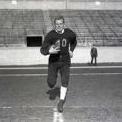-
Posts
29 -
Joined
-
Last visited
Content Type
Profiles
Forums
Events
Articles
Posts posted by Stats Junkie
-
-
On 2018-10-18 at 7:09 PM, SpeedFlex27 said:

Cool picture. Unfortunately it has been mislabled. The team wearing the Bison jerseys is the Winnipeg Victorias. The Winnipegs played the Victorias 3 times in 1935. Rebholz scored his rushing TD early in the 3rd quarter of the game played on October 5, 1935.
- JCon and Fatty Liver
-
 1
1
-
 1
1
-
Here is a little history on the evolution of player positions
In the early days, the wingline (O-Line) consisted of 1 x snapback (centre), 2 x inside wing (Guard), 2 x middle wing (Tackle) & 2 x outside wing (End)
The backfield consisted of 1 x quarterback, 3 x halfback
The final position was a flying wing (FW). Flying indicated that the player possessed the speed necessary to make end runs (similar to a halfback). Wing represented the physical stature needed to fill on the wingline. The combination of size and speed also made the FW the ideal candidate to take the snap from centre on an extension play (similar to rugby).
Mid 1930's - the increased American influence saw the modern terminology for the O-Line come into vogue. The 3 HBs became 2 HBs and a FB (fullback). American coaches were used to operating an 11 man formation and they didn't know how to incorporate the FW. During the 1940's the FW often lined up as a flanker simply as a way of staying out of the way.
By the late 1940's, the FW started to become more involved in the offence as a true flanker (receiver).
1955 - Winnipeg adopted a new backfield alignment. HB FB FB HB
1964 - Winnipeg became the last team to adopt a more modern look to the offence. The ends were now defined as a tight end (TE) and a split end (SE). The backfield now consisted of HB FB HB FL (flanker)
~1970 - the wingback (precursor to the slotback) was introduced, replacing one of the HB positions. The wingback (WB) was used as a runner and a receiver.
During the 1970's we saw the introduction of the term runningback which eventually replaced the HB.
By the late 1970's there was another change in positions. The SE & FL were renamed wide receivers (WR). The WB & TE became slotbacks. The backfield now consisted of a RB & FB.
Prior to 1950, substitutions were limited in Canadian football. If a player subbed out of the game, he could not return until the following quarter. As a result, players were required to play both ways which meant there were no formal positions for the defensive side of the ball.
A common lineup could include E T G G T E on the d-line with HB FB C HB in the second row and the QB occupying a safety position. The FW would often lineup based on where the opposing FW was positioned.
1950 - With free substitutions now permitted we saw the introduction of formal defensive positions. Winnipeg ran a 5-4-3 lineup with DE DT MG DT DE on the line, CLB ILB ILB CLB as linebackers & DHB S DHB in the defensive backfield. MG = middle guard, CLB = corner linebacker.
1965 - Winnipeg shifted to a 4-3-5 defensive alignment. It saw DE DT DT DE on the line with OLB MLB OLB as linebackers and CB DHB S DHB CB in the defensive backfield.
Winnipeg has also used a 3-4-5 formation (common throughout the Cal Murphy years). It saw DE NT DE on the line & OLB ILB ILB OLB as linebackers.
I am not sure if this clears things up or just muddies the water a little.
- WBBFanWest, MC, bearpants and 5 others
-
 8
8
-
Long time lurker - first post
The DHB position would be incomplete without Dr. Tom "Citation" Casey.
Casey played for the Blue Bombers 1950-1955. He earned an all-star nod each season.
For 1950-1952 he was an all-star halfback. This was the end of the era when the WIFU only issued a 1st and 2nd all-star team and did not differentiate offence from defence. He was best known for his defensive play although Casey would likely have been an all-star on offence and defence in 1950 & 1952.
For 1953-1955, Casey was an all-star at defensive halfback.
Interceptions were first tracked by the WIFU in 1952. Casey finished 2nd with 7 interceptions in '52, 1st in '53 with 7 & 3rd in '54 with 6. Based on newspaper accounts, Casey had at least 10 interceptions in 1950.
- Eternal optimist, bearpants and Jesse
-
 3
3



The MBB All-Time Blue Bomber team
in Blue Bomber Discussion
Posted
I'll admit that I have never heard of the monster position before.
I found this on Yahoo Answers
There are a number of variations in terminology - anyone remember the Jack position from 2011?